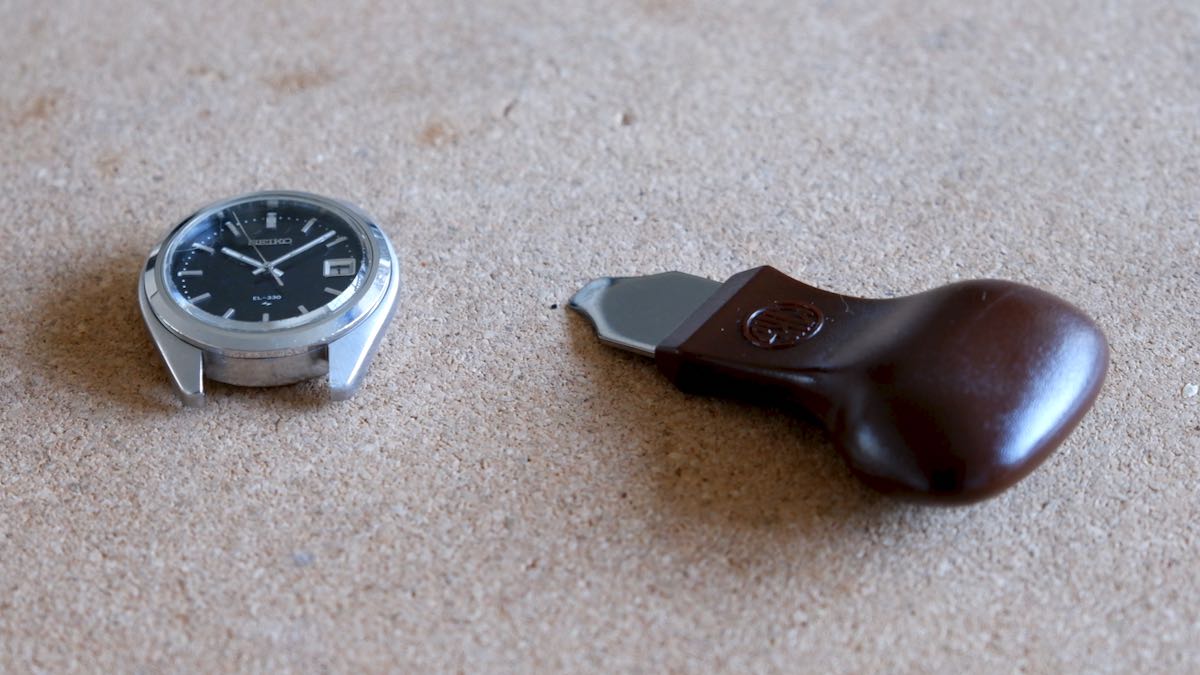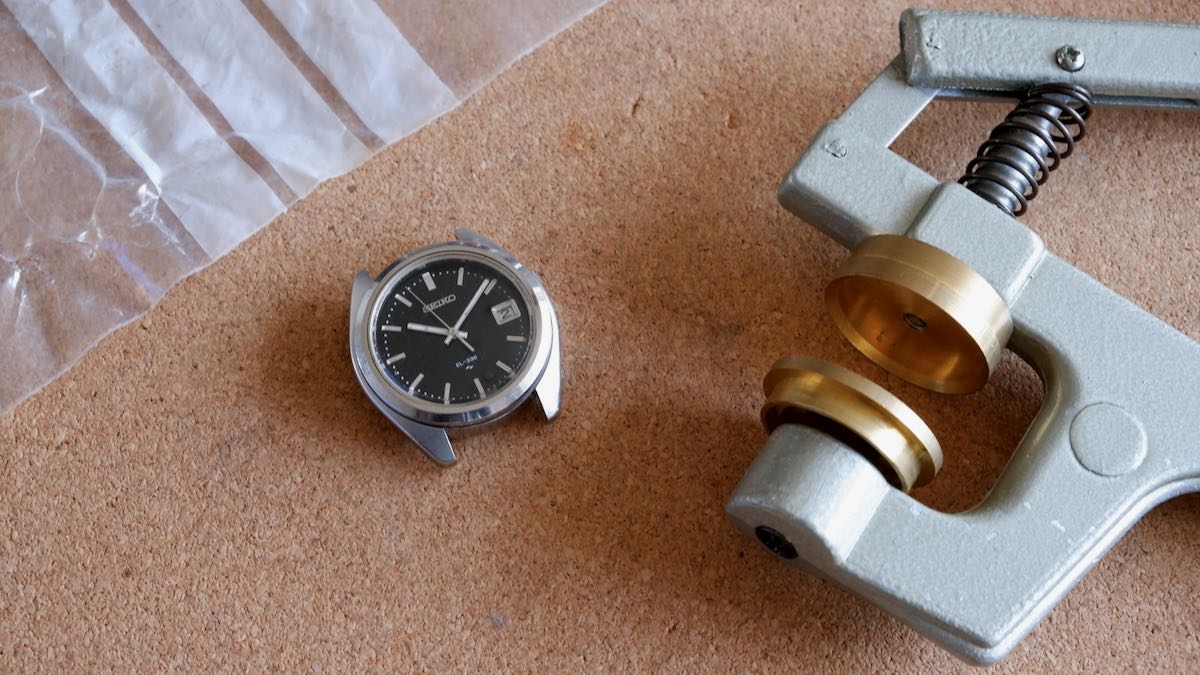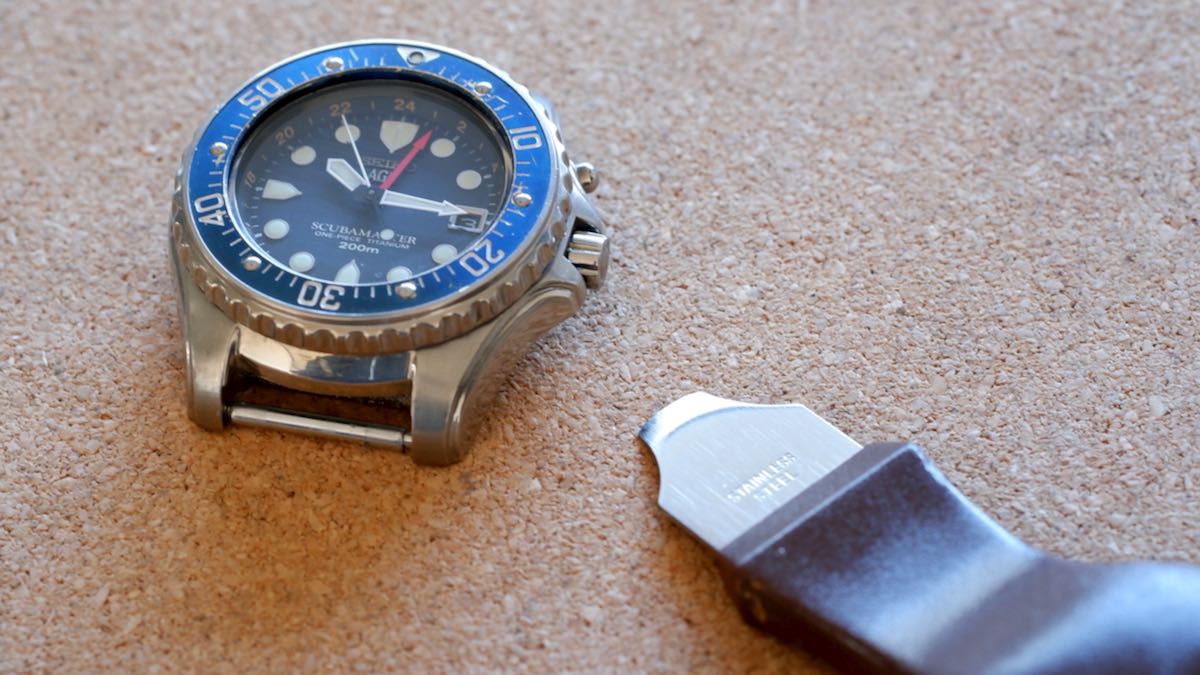How to open a Seiko monocoque (one-piece) watch case

Although most Seiko watches have a caseback that you can prise off or unscrew, some have monocoque cases that are a single piece of steel or titanium and the watch movement is accessed from the front. It's not always obvious how to open these so here's a guide for three styles of monocoque case.
Basic monocoque case
Let's start with a simple one, in this instance a Seiko 3302-8080 electronic watch. With no rotating bezel or push buttons, it's basic compared to one-piece divers or chronographs.
Step 1
For all of these case types, it's much easier if you have a proper case opening tool. A penknife might work but there's more risk of slipping and causing damage — to the case or yourself. A dedicated opener has a sharp and very strong steel blade, with a comfortable rounded handle.

Step 2
Between the case and the bezel there should be one area that has a small notch. It's hard to spot but usually between the lugs, and this is where you push in the case opener. You can also put masking tape on the case first to reduce the risk of scratching. One important thing is don't lever or wiggle the blade up and down. Just push the blade in to widen the gap slightly, then move around the case a bit more and push the blade in again. Continue doing this until you hear a snap or the bezel lifts enough to pull off easily.

Step 3
With the bezel off, the crown should come off easily too. Don't force it — if it feels tight then you may need to use a suction cup to lift it off (see the diver example below).

Step 4
There should be a rubber gasket below the crystal. It may be hardened or stuck on with age so very carefully use tweezers or other sharp object to lift it up bit by bit.

Step 5
To remove the movement you first need to remove the crown and stem. This is done by pushing a small stem release lever which can be seen between the dial and the case somewhere between the 2 o'clock and 4 o'clock positions. While pushing the lever with tweezers or a spring bar tool, gently pull out the stem. If this lever is missing then you'll need to remove the hands and dial to access the area where you can release the stem — quite a pain!


Re-assembly
Re-assembly is just the above steps in reverse, however the bezel is usually hard to push back on so you'll probably need a crystal press as in the photo below, with plastic sheet to protect the bezel.

Diver monocoque case
Monocoque cases are particularly suited to diving watches, to reduce the number of places where water could seep in. This example shows a Seiko 5M45-6A30 "Stingray" but the process is similar for others such as Seiko "tuna" watches. Again, a proper opening tool is strongly recommended.
Step 1
This case is made of titanium which is more prone to scratching than stainless steel, so consider using masking tape to reduce the risk of scratches. Unlike the first watch above, there is no notch. Instead, you push the opener anywhere between the bezel and case, although I recommend close to the 6 o'clock area to avoid hitting a click ball, if there is one. As before, don't lever or wiggle the blade up and down. Just push the blade in to widen the gap slightly, then move around the case a bit more and push the blade in again. Continue doing this until you hear a snap or the bezel lifts enough to pull off easily.

Step 2
With the bezel off, we can see the retaining ring which requires a screw case opening tool. These are surprisingly sharp and notorious for slipping and causing scratches, so make sure you have a firm grip and twist anti-clockwise, starting gently and increasing strength gradually. Even when loosened, continue to move slowly so you don't slip by accident.


Step 3
The crystal below the retaining ring is likely to be firmly pressed in for water resistance, so you'll need a suction cup to remove it. This is a cheap one from my local DIY/hardware store which has a lever on to increase suction. Place it flat on the crystal, press the lever if it has one, and pull off carefully. The dial and hands are now exposed so make sure the crystal is far away before you remove it from the suction cup.


Step 4
With the chapter ring also removed, we can see the stem release lever on the right. The stem removal procedure is the same as before — push the lever towards the back of the case with tweezers or a spring bar tool while pulling the crown. Don't forget to unscrew the crown first!


Two-piece monocoque case
"Two-piece monocoque" may be an oxymoron, but this style of case has an upper part that needs to be removed to access the movement in a solid lower part. They're often square in shape. In this example, the watch is a Seiko 7018-5000 "Monaco".
Step 1
Look for metal tabs in the side of the case. There may be one or two per side, and on both sides. If there covered in dirt, it might be worth cleaning it off with a brush or toothpick first.

Step 2
With a case opener or strong thin object, push in the tab. Don't try to open the case at this point — just press in the tab so that it rests on the inside of the case and doesn't pop back out. Do the same thing on the other side. With both tabs pressed in, now gently prise up the case bit by bit through the tab hole until you can pull the case apart with your fingers. If you can't press in either of the tabs, look closely for any dirt getting in the way behind the tab and try clearing it with toothbrush bristles.

Step 3
Now you should be able to gently lift off the crystal.

Step 4
If the gasket is stuck to the case, use a sharp tool to gently release it around the edge. Don't pull the gasket off until you've released it at all sides and corners. You may have to re-use the gasket if it's an unusual shape so avoid stretching it.

Step 5
The stem can be released by pushing the stem release lever under the gasket, as in the other examples. Disassembly is now complete apart from the chronograph pushers, but I'll leave those for another day…

If you liked this, check out more articles about repairing, restoring and enjoying Seiko watches.